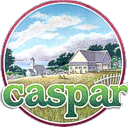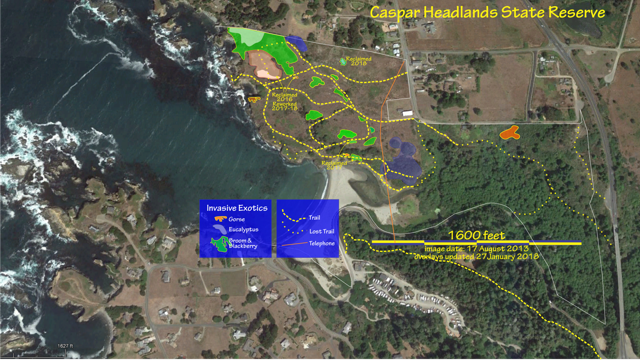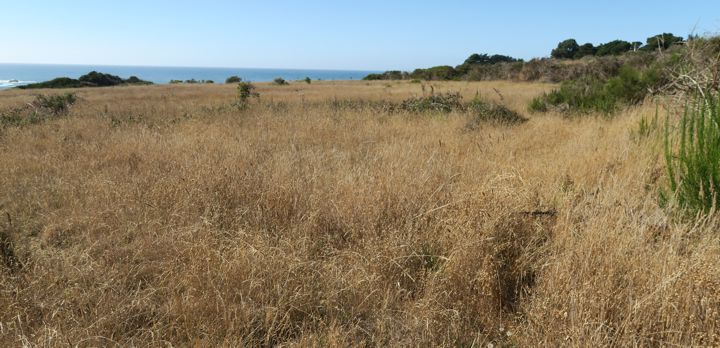
home
 home |
Home Planning Maps FAQ Library Gallery Press Rentals Calendar Donate |
Caspar Headlands portal |
Caspar Headlands: Our Village’s Front YardOut grubbing Gorse on the Caspar Headlands State Reserve, I sometimes think of the legendary Oklahoma Guarantee: "And if it breaks, you get to keep both parts." Caspar Community united and worked hard to get our Headlands protected under the care of State Parks, and part of our unwritten agreement was that we'll provide volunteer local labor to take care of it. We do that in an organized way (as organized as anything is in Caspar) every month, on the fourth Saturday of the month, from 10 am until we need to stop. Some of us are usually worse for the work. Pulling up living plants is hard. If you can come and help — if you love the Headlands as much as we do — don sturdy shoes, grab gloves and your favorite implements of abatement, and join us. (If you want to be reminded, email your request to lists@casparcommons.org .)  Larger Map (2.7Mb) : Huge Map (11.6Mb) Shamli Tarbell’s “Caspar Headlands Design Considerations”Caspar Headlands Interactive MapWhy we Fear Gorse: FireBesides being a great collection of trails along the shore and down to the beach, Caspar Headlands is a large, open, flammable meadow largely covered with invasive exotic plants: Eucalyptus, Gorse, Broom (2 kinds), Himalaya Blackberry, Thistle, Heather, Pampas Grass, Monterey Cypress, and (because it was once a pasture where cows were fed with trucked in hay) several European species of "wrong grasses." Some of these fight us for the trails, and we fear others for the fire hazard they represent. Fighting Fire with FireAfter decades of battling Gorse with conventional means – brush hog (a tractor with a powerful mower), chain saws, black plastic covering, tarps – those of us who take a long-term view of Gorse, and the threat it poses to our adjacent properties, we have convinced ourselves that there are only two ways to permanently end the infestation. Smaller plants can be uprooted with a Weed Wrench and lots of aggression. If much of the root breaks off, the plant survives. Just cutting the plant strengthens the root system – the really dangerous, oily part of the plant. Large plants do not yield to anything less than beheading with a chain saw (chain mail for the operator is not a bad idea, too) and then, as soon as possible, a careful topical application of powerful herbicide glyphosate to the cut stems. This is a controversial method: those who fear Gorse, and want to be rid of it in our lifetime versus those who are afraid of chemical measures. You can read more about this controversy here.
Headlands and Gorse infestation have been partners for decades. Possibly introduced to the Headlands by the Lumber Company to control erosion along the bluff nose, it has three well-established bases on the plain, at which we constantly hack away. We triumphed (mostly, and with terms) over the Eucalyptus that was overtaking the Headlands from the north, thanks to State Parks, a Coastal Commission concession (that Eucalyptus is a weed, not a tree) and CalFire, a team of trainees came for a week-long workshop on felling trees quickly and safely. ( Read more about that starting here. ) 4th Saturday Work Day: A Little Bit at a TimeOnce a month (4th Saturday from 10am at the south end of Caspar Road) a small group of dedicated volunteers meets to spend a couple of hours working to control the exotic invasive plants on our Headlands. Under the supervision of State Parks, we focus on one or two seasonally appropriate invasive plants. So little time, so much to grub! The Grubbing Year begins when the ground is well-soaked with the first good rains. With weed wrenches and other implements of destruction, we uproot our most stubborn opponent, Gorse (Ulex europaeus, an invader from the Hebrides.) () Gorse grubbing season extends into May; thereafter, the Gorse is too firmly rooted, and even with the tops broken off, the hardy roots resprout as soon as it rains. Gorse flowers during this period, and one common question we Gorse grubbers love to answer is 'They're such pretty flowers; why are you cutting them down?' ()
In September 2016, only a half dozen weak resprouts remain ...and we'll surely get 'em as soon as the rains come. Of course, we have multiple other Gorse clumps to tackle in 2017. Broom (Genisteae tribe) can also be grubbed, and pulling broom plants up by the roots is definitely satisfying, and the surest way to stop the infestation's inexorable march. As far as we can tell, cutting the broom as close as possible to the ground usually kills the plant, and a year or so later the roots are sufficiently brittle that stumps can be broken off and the ground cleared. Unfortunately, although Gorse and Broom are distant relatives, this 'cutting close to the ground' trick doesn't work on Gorse. Broom is also easier than Gorse because it doesn't fight back. Full-grown Gorse brandishes two-inch long spines that really penetrate. A major clearing effort by State Parks and CalFire in 2016 liberated a large area on the Headlands.  Broom Gone — late September, 2016 This whole field was covered with Broom as large as that visible on the border, eight feet tall. About the time the ground hardens up, it's thistle season. We have at least three species, and they are having a very good year. The best time to get them is before their flower heads start to form ... but Will Richnow is developing a technique for bagging the blossoms before their seeds hit the breeze. Eucalyptus used to rank right up there with Gorse as an enemy and a fire threat; with heroic help from State Parks, this invasive pest has mostly been eliminated from the Headlands. The massive stand of old-growth Eucalypts have been cut, and only their whitening stumps can still be seen ...but eight years after the clearing, the youngsters are still resprouting from their vigorous roots. At least once a year, a search-and-destroy day for Eucalyptus resprouts is conducted. The resprouts, it turns out, have a very tenuous connection to the old growth, and can usually be twisted off and stacked to dry. After a few years of this unrewarding behavior, the typical Eucalyptus gives up and dies. Our species is resistant to rooting, and so evidence of the 2008 project still make the upper area of the Headlands a dangerous place to walk. Heather (Ericaceae family) has finally come to loom large on our invasive radar, and in 2016 we got a good start on this invader. It blooms and seeds early, and so is eligible for attention in the Fall before the rains come, when its brittle root crowns can often be broken off at the roots. Cutting the younger, more flexible stems undoubtedly leaves viability in the root crowns, and so this species also needs to be revisited again and again for years. Our Headlands used to be a lumber yard as well as the location of several dozen cabins and houses, and the Heather, like the Rock Roses and Calla Lilies, are survivors from domestic flower gardens. Our methodology: The Bradley Method of Eliminating Exotic Plants from Natural Reserves page updated 28 January 2018 mrp
|
|
Home Planning Maps FAQ Library Gallery Press Rentals Calendar Donate |
|
Caspar Community Center 15051 Caspar Road Caspar, California 95420 - box 84 707-964-4997 | |
|
If you would like to receive email about hometown Caspar events, email your request to lists@casparcommons.org. | |
|
find Caspar Community Center on: |
|
| Community web hosting donated by Mendocino Community Network Thank you, MCN! for more information, email the Caspar Community Coordinator, caspar@mcn.org |
| copyright © 2024 Caspar Community permission to reprint is hereby granted and EARNESTLY desired |
|
: : last updated 29 April 2019 : 12 pm (s) : : printed with 100% recycled electrons! for website feedback, email the Caspar Village webster |